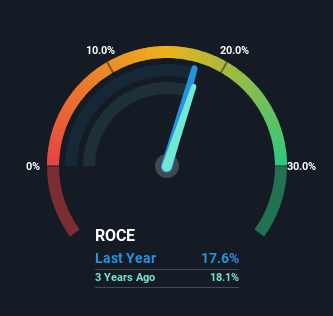Returns On Capital Signal Difficult Times Ahead For Hello Group (NASDAQ:MOMO)
What underlying fundamental trends can indicate that a company might be in decline? When we see a declining return on capital employed (ROCE) in conjunction with a declining base of capital employed, that's often how a mature business shows signs of aging. This indicates the company is producing less profit from its investments and its total assets are decreasing. So after we looked into Hello Group (NASDAQ:MOMO), the trends above didn't look too great.
Return On Capital Employed (ROCE): What Is It?
If you haven't worked with ROCE before, it measures the 'return' (pre-tax profit) a company generates from capital employed in its business. Analysts use this formula to calculate it for Hello Group:
Return on Capital Employed = Earnings Before Interest and Tax (EBIT) ÷ (Total Assets - Current Liabilities)
0.18 = CN¥2.0b ÷ (CN¥16b - CN¥4.4b) (Based on the trailing twelve months to June 2023).
Therefore, Hello Group has an ROCE of 18%. On its own, that's a standard return, however it's much better than the 7.0% generated by the Interactive Media and Services industry.
See our latest analysis for Hello Group
Above you can see how the current ROCE for Hello Group compares to its prior returns on capital, but there's only so much you can tell from the past. If you'd like, you can check out the forecasts from the analysts covering Hello Group here for free.
What Does the ROCE Trend For Hello Group Tell Us?
In terms of Hello Group's historical ROCE movements, the trend doesn't inspire confidence. To be more specific, the ROCE was 27% five years ago, but since then it has dropped noticeably. And on the capital employed front, the business is utilizing roughly the same amount of capital as it was back then. Companies that exhibit these attributes tend to not be shrinking, but they can be mature and facing pressure on their margins from competition. If these trends continue, we wouldn't expect Hello Group to turn into a multi-bagger.
While on the subject, we noticed that the ratio of current liabilities to total assets has risen to 28%, which has impacted the ROCE. Without this increase, it's likely that ROCE would be even lower than 18%. Keep an eye on this ratio, because the business could encounter some new risks if this metric gets too high.
The Bottom Line
In summary, it's unfortunate that Hello Group is generating lower returns from the same amount of capital. Long term shareholders who've owned the stock over the last five years have experienced a 68% depreciation in their investment, so it appears the market might not like these trends either. Unless there is a shift to a more positive trajectory in these metrics, we would look elsewhere.
If you want to continue researching Hello Group, you might be interested to know about the 1 warning sign that our analysis has discovered.
If you want to search for solid companies with great earnings, check out this free list of companies with good balance sheets and impressive returns on equity.
Have feedback on this article? Concerned about the content? Get in touch with us directly. Alternatively, email editorial-team (at) simplywallst.com.
This article by Simply Wall St is general in nature. We provide commentary based on historical data and analyst forecasts only using an unbiased methodology and our articles are not intended to be financial advice. It does not constitute a recommendation to buy or sell any stock, and does not take account of your objectives, or your financial situation. We aim to bring you long-term focused analysis driven by fundamental data. Note that our analysis may not factor in the latest price-sensitive company announcements or qualitative material. Simply Wall St has no position in any stocks mentioned.

